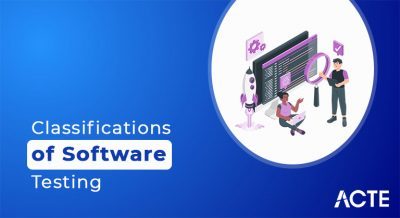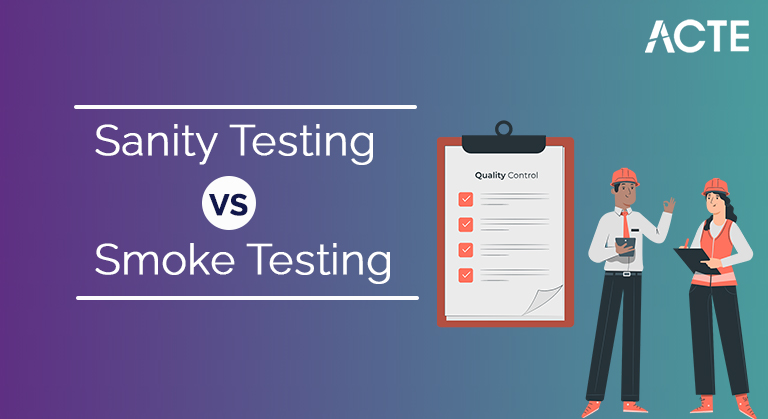
Smoke testing is done to measures the stability of the system/product by performing testing. Sanity testing is done to measures the rationality of the system/product by performing testing. Smoke testing is used to test all over function of the system/product.
- Introduction to Sanity and smoke testing
- Which test comes first smoke or sanity?
- Key features of Sanity testing and Smoke testing
- Smoke Vs Sanity Testing
- Do we write test cases for sanity tests and smoke tests?
- Process of Sanity and smoke testing
- When should you conduct sanity testing? Vs Smoke Testing?
- Benefits of smoke and Sanity
- Conclusion
- Smoke testing, commonly known as structural verification testing, looks at problems at certain stages of the system rather than the entire application. Used to test software performance. When developers bring a new structure to Quality Assurance teams, smoke testing is done. However, it is not just the beginning of a new project. Smoke testing will continue to work even if new modules are added to current performance. It is done by both testers and developers because it is easy and requires less time. It is part of a comprehensive evaluation process, and uses test cases to ensure that all key components of the structure function properly.
- It is a software testing method used after software development to ensure that the key features of the software are working properly. It is started before any active or reversible tests are performed in detail. The basic goal of a smoke test is to reject a flawed software program so that the QA team does not waste time testing defective software. Smoke testing is part of the acceptance test.
- Smoke testing can save the test effort while improving the quality of the application. Based on client and organisation, smoke testing can be done manually or automatically. “Building Verification Testing” or “Confidence Testing” are some of the principles of smoke testing. Typical smoke testing may include things like making sure the app is running successfully, testing GUI responses, and so on.
- Integrity testing determines whether the modules of a new module in existing software development are stable enough to proceed to the next phase of testing. This is also known as Advanced Testing, and it is necessary to immediately check the quality of the software backing. Sanity tests indicate that the final structural test can be performed easily in the event of minor code changes. If the psychological test fails, the structure is rejected in order to save time and money on a thorough examination.
- Sanity testing also confirms that any changes made do not affect other software design capabilities. Sanity testing is a type of retrofit test used for quality assurance. The main purpose of a psychiatric examination is to ensure that the proposed modification or performance works as intended. If the psychological test fails, the testing team will reject the software product to save time and money. Only when the software product has passed the smoke test and has been approved for further testing by the Quality Assurance team.
- The goal is to verify the “appropriateness” of the application before proceeding with further testing. Sanity testing is part of the retreat test. Because mental Sanity is a subset of regression tests, it may also be automatic.
- Consider an e-commerce project with five modules: home page, login page, new user creation page, user profile page, etc. The username on the login page must not be less than 7 characters, subject to conditions, and the problem occurs when a username with less than seven characters is approved.
- The problem is then reported to the developers’ team, which is responsible for fixing it. The development team is now fixing the problem and returning it to the testing team for double testing. Subsequent testing teams ensure that the problem fixed by the development team does not interfere with the operation of other modules.
Introduction to Sanity and smoke testing:
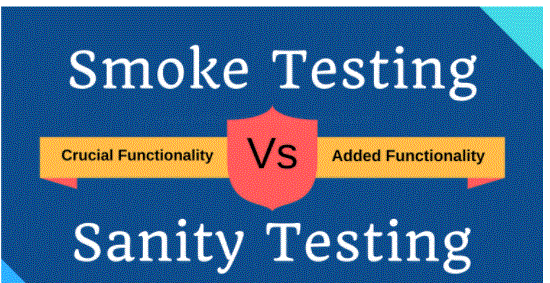
Which test comes first smoke or sanity?
Smoke tests are performed first followed by a psychiatric examination. During the early stages of the software life cycle (SDLC), smoke testing is performed. While mental Sanity tests were performed during the final stages of the SDLC.
The QA team may be required to perform Sanity, Smoke, and Descent tests in their software design depending on test requirements and time limits. In such cases, a smoke test is performed first, followed by a Sanity test, and then a drop test is scheduled based on the time available. Smoke testing occurs immediately after installation of a building, while mental Sanity testing occurs once troubleshooting has been completed.
- Smoke and Sanity testing saves QA team time by quickly determining whether an application works well or not. It also ensures that the product is eligible for further testing.
- The Sanity and Smoke test is two ways to avoid wasting time and effort by checking that the app is too flawed to be properly tested.
- Conducting daily construction and smoke inspections on software projects is one of the industry’s best alternatives.
- Smoke and Sanity tests can be done in person or with the help of an automatic tool.
- You may need to do both the Sanity and Smoke tests in the software building depending on the testing requirements. In such cases, you will do a Smoke test first, followed by a Sanity Test. Sanity testing cases are often combined with industrial smoke testing conditions to speed up testing performance. As a result, words are often misunderstood and used interchangeably.
Key features of Sanity testing and Smoke testing:
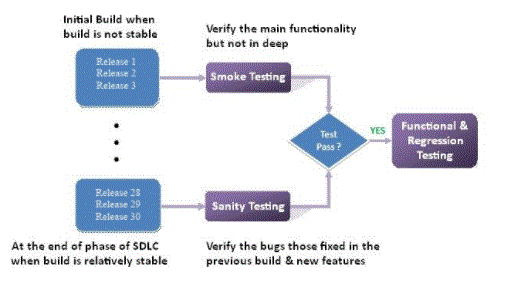
- Details Smoke testing Sanity.
- The purpose smoke test is performed to ensure that the system’s efficient operation is effective. Sanity tests are performed to check that the bugs have been repaired after construction.
- Documents Smoke tests can be written and recorded. Sanity tests cannot be written and are not written.
- Basis for testing The main purpose of this test is to ensure that the newly constructed structure is stable enough to withstand severe testing. The primary purpose of this test is to determine system integrity and accuracy to ensure that the proposed activity performs as intended.
- It is made by both developers and testers. It was done by inspectors.
- Subset is a series of acceptance tests. It’s a subset of retrofit tests.
- Made in Smoke Test first done in the original building. Purity checks are performed on a stable structure or new software components
- Cover Includes basic operation at the end to end of the system. Includes specific modules, in which code changes have been made.
Smoke Vs Sanity Testing:
Do we write test cases for sanity tests and smoke tests?
Both smoke tests and psychological tests can be done manually or automatically. You do not need to develop new test cases to perform a smoke test; instead, you can simply select the appropriate test conditions that have been specified by the program planners. The main goal here is to explore the basic process of the application. Just select test scenarios that describe the main functions of your software.
- Diagnosis
- Testing
- Testing
Process of Sanity and smoke testing
The main purpose of performing a psychiatric examination is to evaluate incorrect results or errors that are not in part processes. Also, make sure that newly added features may not affect the performance of current features.
Therefore, we need to follow the steps below in order to apply the Sanity test step by step:
Step 1: Identification
The first step in the hygienic testing process is diagnostics, in which we discover new parts and features and the modification introduced in the code while fixing the bug.
Step 2: Measurement
After completing the identification step, we will analyse the newly installed components, attributes and adjust them to evaluate their intended performance and suitability according to the requirements provided.
Step 3: Testing
Once the diagnostic and testing step has been successfully processed, we will move on to the next step, which is testing. In this step, we evaluate and evaluate all the connected parameters, components, and significance of the above analyses described and modified to ensure their effectiveness. If all of the above steps work properly, the structure can be subjected to more detailed and exhausting testing, and the output can be transferred for full testing.
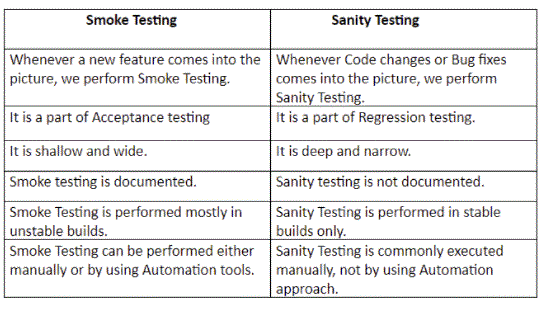
- When new software functions are built and integrated with an existing QA / stage structure, smoke testing is performed. It ensures that all important functions are active or not. It also checks whether the building is stable or not.
- The development team uses construction in QA in this testing process. The lower parts of the test cases are identified, and the test cases are performed by the inspectors on site. Key features of the app have been tested by the QA team. The purpose of this set of test cases is to identify structural errors. If all of these tests are successful, the QA team will move on to Functional Testing.
- Any failure means that the system must be restored to the development team. We perform a Smoke Check whenever there are changes in the structure to ensure stability.
- Let’s take a look at the basic situation where you are given an email request to check it out. Getting into the email system, writing email, and sending it are very important features, right? Is it worth checking out additional features such as drafts, deleted messages, archives, etc. if the email is not sent? This means you will have to dispose of the property without further testing. This is called a smoke test.
- Built after a lot of reversal or if there is a slight change in the code.
- After the bug fixes, the structure is shipped.
- Just before the production post.
When should you conduct sanity testing? Vs Smoke Testing?
Smoke test:
Sanity Testing:
- Increase the efficiency of quality assurance staff. QA teams will be more productive and satisfied with their work if they rely heavily on efficient and effective smoke detectors.
- The goal is to verify the “stability” of the application before proceeding with further testing.
- Helps to detect errors in the early stages.
- Reduces the risk of merger.
- Sanity testing helps to quickly detect problems in basic operation.
- Because there are no documents required for mental Sanity, they may be completed in a short period of time.
- If problems are detected during a mental Sanity test, the project is rejected, which saves the duration of the retraining test.
- The team is focused on verifying the effectiveness of the application rather than the overall assessment. Sanity tests are usually performed on a site where production shipments are urgently needed, such as a significant disruption patch.
Benefits of smoke and Sanity:
Smoke test:
Sanity Testing:
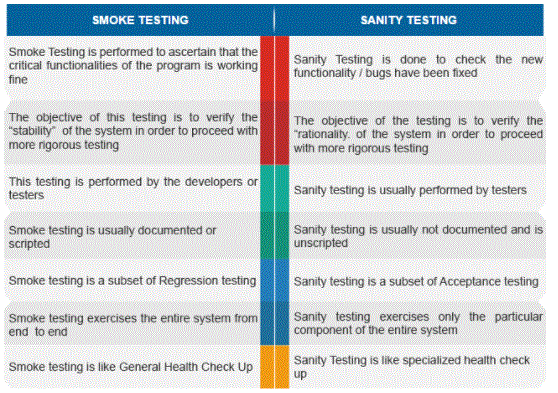
Conclusion
Finally, after learning about the Smoke vs test. Sanity, it is time to end our debate by summarising the main points of this article. You can see why these two methods are so different from one another and why they are so useful components in software testing.
These are the basic test ideas most of the quality assurance and project teams in the various software development projects adhere to. To obtain effective and acceptable Quality Assurance Outcomes, beginners should understand the principles of Smoking and Sanity testing. Sanity and smoke testing are two ways to save time and energy by quickly determining that an application is so corrupt that it cannot pass any complete test.




